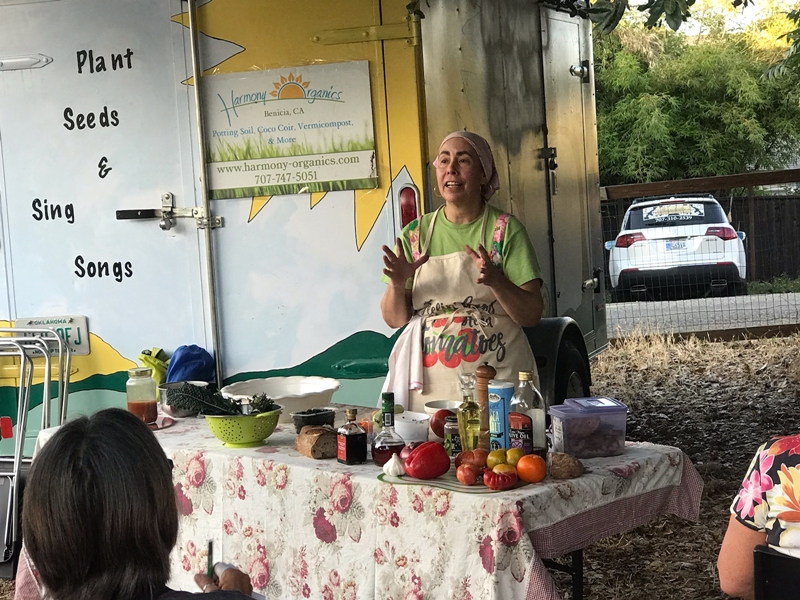By Lisa Núñez-Hancock, Culinary Arts Instructor

Lisa Núñez-Hancock teaches a cooking class at Avant Garden
During these times of disease, it is important to find ways to keep your body healthy. Sleep, lowering stress levels, exercise in nature and eating healthy high-fiber foods are all ways of maintaining a healthy immune system.
Over the last decade, scientists and research have uncovered just how profoundly our microbiota (aka gut bacteria) is wired into our immune system, our metabolism, our central nervous system and even our brain. The microbiota is a complex organism, one that I have a particular passion for understanding.
In this brief article I want to focus on plant-based, fresh foods that will assist you in maintaining a strong and well-functioning immune system. It is my belief that instead of spending a lot of money on expensive supplements and industrial, laboratory-produced products, we should focus on natural foods in their most basic, least expensive, and most easily accessible form. In the simplest terms, our microbiota thrive on fiber and the resulting carbohydrates that derive from plant material.
Our gut microbes thrive on dietary fiber found in plants, such as vegetables, fruits, whole grains, nuts, seeds and legumes, according to research from the Stanford University School of Medicine at The Sonnenberg Lab.
There are numerous natural, fresh foods that researchers tell us are beneficial to boosting our immune health through feeding our microbiota.
Cruciferous Vegetables, also known as brassica oleracea, are packed with vitamins A, C and E, as well as fiber. Studies, such as those referenced in this blog post, indicate that vitamins C and E act as powerful antioxidants that help to destroy free radicals and support the body’s immune response. Cruciferous vegetables include Broccoli, Brussels Sprouts, Cabbage, Cauliflower, Collards, Kale and Kohlrabi.
Leafy Green Vegetables are yet another source of varied nutrients and fiber. Those include Spinach, Micro-Greens, Watercress, Arugula, Swiss Chard, Beet and Turnip Greens.
I can’t sing the praises of Mushrooms enough. I encourage you to research them on your own. In a study conducted at the University of Florida’s Institute of Food and Agricultural Sciences, researchers found evidence of increased immunity in participants who consumed shiitake mushrooms daily. Not only do they fight inflammation, they are also anti-bacterial, anti-fungal and anti-viral. There are medicinal ones and culinary ones (and of course poisonous ones) Some immune-boosting culinary varieties include Shiitake, Maitake (aka Hen of the Woods), Enoki, Oyster and Lions Mane.
I want to recommend three local sources where I get both my culinary and medicinal mushrooms. IntregiTea in Vallejo, and my new BFF’s at E & H Farms, as well as all those great folks at Far West Fungi! We are so lucky to have these resources in our “neck of the woods.”
We are all lucky to live in California, with beautiful thriving citrus crops. We all know Citrus is a source of important immune boosting vitamin C and fiber, both important to healthy immune functioning. These can include Oranges, Lemons, Limes, Grapefruit, Tangerines and Clementines.
Some additional immune-boosting foods include Garlic, Turmeric, Ginger, Almonds, Red Bell Peppers, Papaya, Kiwi, Pomegranates, Sweet Potatoes, Sunflower Seeds, Miso and Wheat Germ.
Variety is the key to proper nutrition. Eating just one of these immune-boosting foods won’t be enough to help fight the flu or seed your microbiota with enough diversity to fight chronic diseases, even if you eat it regularly. Pay some attention to serving sizes and recommended daily intake so that you don’t get too much of a single nutrient, and too little of others. That may sound complicated, but trust your gut, so to speak.
Before the COVID-19 outbreak I had scheduled a September workshop on the microbiome with probiotic foods for good gut and mental health to be taught in collaboration with a mental health professional. I am presently taking a UC Berkeley course online that among other food-related topics, deals with the latest research in the realm of microbiota. So, hopefully in some context I will be able to bring this information and recipes to the community in the future. I’ll also be addressing fermented foods and their probiotic properties, as I have done in past workshops. If this is an interesting topic to you, I highly recommend the work of Erica and Jason Sonnenburg out of Stanford University — my heroes in the microbiota field.
Again, I can’t stress the importance of natural homemade probiotics and good gut health. But that is an article/workshop for another day.
Immune-Boosting Broth
Here is my recipe for an immune-boosting broth that can be used by itself, or as a base for soups, stews and sauces.
1 cup of greens (Kale, Spinach and/ or Watercress)
1 cup sliced mushrooms (Shiitake, Oyster and/or Enoki)
1 peeled red onion, quartered
1 peeled shallot, halved
2 garlic heads, unpeeled and cut horizontally
1 fresh ginger piece, (thumb-size) peeled and sliced
1/2 cup thinly sliced radishes
1 jalapeño, (hot) thinly spiced
4 sprigs each of fresh sage, basil and thyme
2 Tablespoons extra-virgin olive oil
2 Tablespoons apple cider vinegar and/or fresh lemon juice
1/4 teaspoon sea salt or to taste
In a dutch oven or stock pot combine all the ingredients (see options below) and add 3 quarts of water. Cover and bring to a boil. Reduce the heat to a gentle simmer and cook 20-30 minutes or until the flavors are blended.
Personally, I like to eat everything in this pot, but that may not appeal to everyone.
Here are some options:
- Instead of cooking them, add raw radishes and sliced jalapeños as a garnish when serving.
- Remove sprigs of herbs and squeeze garlic out of heads, discarding the husk before serving.
- The broth can be completely strained, but it seems like such a waste to discard these veggies and all their immune-boosting nutrients and fiber.

